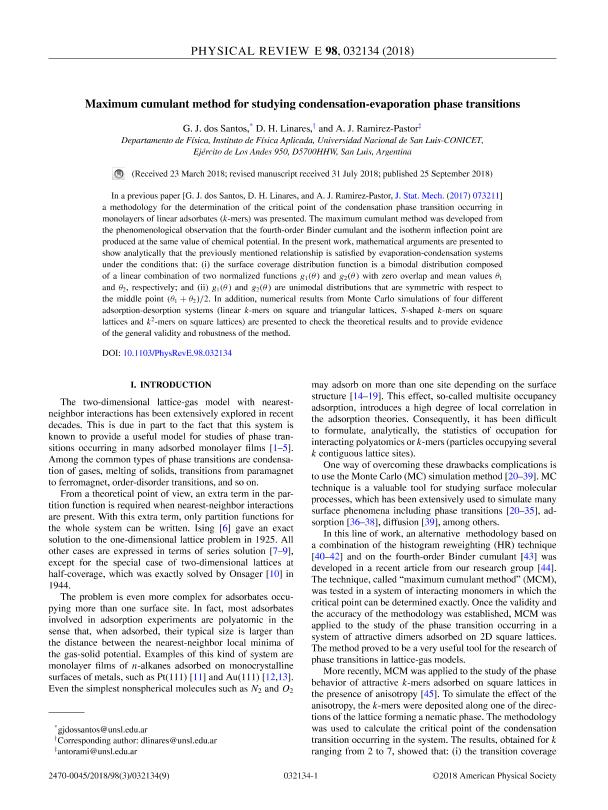Mostrar el registro sencillo del ítem
dc.contributor.author
Dos Santos Mendez, Gonzalo Joaquín

dc.contributor.author
Linares, Daniel Humberto

dc.contributor.author
Ramirez Pastor, Antonio Jose

dc.date.available
2019-10-18T21:36:01Z
dc.date.issued
2018-09
dc.identifier.citation
Dos Santos Mendez, Gonzalo Joaquín; Linares, Daniel Humberto; Ramirez Pastor, Antonio Jose; Maximum cumulant method for studying condensation-evaporation phase transitions; American Physical Society; Physical Review E; 98; 3; 9-2018; 1-9
dc.identifier.issn
2470-0053
dc.identifier.uri
http://hdl.handle.net/11336/86514
dc.description.abstract
In a previous paper [G. J. dos Santos, D. H. Linares, and A. J. Ramirez-Pastor, J. Stat. Mech. (2017) 07321110.1088/1742-5468/aa7df2] a methodology for the determination of the critical point of the condensation phase transition occurring in monolayers of linear adsorbates (k-mers) was presented. The maximum cumulant method was developed from the phenomenological observation that the fourth-order Binder cumulant and the isotherm inflection point are produced at the same value of chemical potential. In the present work, mathematical arguments are presented to show analytically that the previously mentioned relationship is satisfied by evaporation-condensation systems under the conditions that: (i) the surface coverage distribution function is a bimodal distribution composed of a linear combination of two normalized functions g1(θ) and g2(θ) with zero overlap and mean values θ1 and θ2, respectively; and (ii) g1(θ) and g2(θ) are unimodal distributions that are symmetric with respect to the middle point (θ1+θ2)/2. In addition, numerical results from Monte Carlo simulations of four different adsorption-desorption systems (linear k-mers on square and triangular lattices, S-shaped k-mers on square lattices and k2-mers on square lattices) are presented to check the theoretical results and to provide evidence of the general validity and robustness of the method.
dc.format
application/pdf
dc.language.iso
eng
dc.publisher
American Physical Society

dc.rights
info:eu-repo/semantics/openAccess
dc.rights.uri
https://creativecommons.org/licenses/by-nc-sa/2.5/ar/
dc.subject
CONDENSATION-EVAPORATION
dc.subject
PHASE TRANSITIONS
dc.subject
MONTE CARLO METHODS
dc.subject.classification
Física de los Materiales Condensados

dc.subject.classification
Ciencias Físicas

dc.subject.classification
CIENCIAS NATURALES Y EXACTAS

dc.title
Maximum cumulant method for studying condensation-evaporation phase transitions
dc.type
info:eu-repo/semantics/article
dc.type
info:ar-repo/semantics/artículo
dc.type
info:eu-repo/semantics/publishedVersion
dc.date.updated
2019-10-15T14:12:00Z
dc.journal.volume
98
dc.journal.number
3
dc.journal.pagination
1-9
dc.journal.pais
Estados Unidos

dc.journal.ciudad
Washington DC
dc.description.fil
Fil: Dos Santos Mendez, Gonzalo Joaquín. Consejo Nacional de Investigaciones Científicas y Técnicas. Centro Científico Tecnológico Conicet - San Luis. Instituto de Física Aplicada "Dr. Jorge Andrés Zgrablich". Universidad Nacional de San Luis. Facultad de Ciencias Físico Matemáticas y Naturales. Instituto de Física Aplicada "Dr. Jorge Andrés Zgrablich"; Argentina
dc.description.fil
Fil: Linares, Daniel Humberto. Universidad Nacional de San Luis. Facultad de Ciencias Físico- Matemáticas y Naturales; Argentina
dc.description.fil
Fil: Ramirez Pastor, Antonio Jose. Consejo Nacional de Investigaciones Científicas y Técnicas. Centro Científico Tecnológico Conicet - San Luis. Instituto de Física Aplicada "Dr. Jorge Andrés Zgrablich". Universidad Nacional de San Luis. Facultad de Ciencias Físico Matemáticas y Naturales. Instituto de Física Aplicada "Dr. Jorge Andrés Zgrablich"; Argentina
dc.journal.title
Physical Review E
dc.relation.alternativeid
info:eu-repo/semantics/altIdentifier/doi/http://dx.doi.org/10.1103/PhysRevE.98.032134
dc.relation.alternativeid
info:eu-repo/semantics/altIdentifier/url/https://journals.aps.org/pre/abstract/10.1103/PhysRevE.98.032134
Archivos asociados
